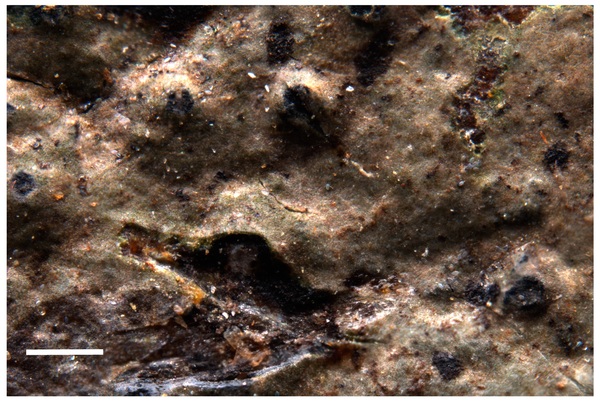Verrucaria devensis (G. Salisb.) Orange
Lichenologist, 46: 607, 2014. Basionym: Leucocarpopsis devensis G. Salisb. - Nova Hedwigia, 26: 351, 1975
Synonyms:
Distribution: C - Sar (Nascimbene & al. 2023).
Description: Thallus crustose, episubstratic, pale grey, dull grey-green to greenish grey, mid-greyish brown or mid-brown, smooth, almost subgelatinous when wet, continuous or cracked in central parts, the cracks at least partially delimiting 40–600 µm wide secondary areoles containing 1–7 perithecia, the surface of areoles typically slightly convex or uneven; prothallus whitish, not fimbriate. Thallus 40-70 µm thick away from perithecia, up to 140 µm thick near perithecia, the cells irregularly arranged or in weak vertical columns, air spaces between cells absent or very few; pseudocortex cells with a dilute or moderately dense brown pigment in the walls; epinecral layer absent or thin, usually indistinct, up to 10 µm thick; dark basal layer present either locally or extensively. Perithecia black, immersed, forming very low projections, the apex at first visible only near the ostiole as a grey, c. 20 µm wide dot, later visible as a grey or black, up to 180 µm wide disc. Involucrellum at first conical, then very wide-spreading and confluent with other involucrella, forming the dark basal layer; surface of involucrellum densely pigmented, below paler, with pigment largely confined to cell walls. Exciple 120–210 µm across, colourless at sides and base. Hamathecium of c. 20-30 µm long periphysoids, interascal filaments absent; hymenial gel hemiamyloid, I+ red (I+ blue at very low concentrations of I), K/I+ blue. Asci 8-spored, clavate, I-, fissitunicate, the wall thickened above, with an ocular chamber, dehiscent by extrusion of an endotunica to form a delicate rostrum, Verrucaria-type. Ascospores 1-celled, hyaline, oblong- ellipsoid, (16-)18-22(-23) x (7.5-)8.5-9.5(-10.5) µm, (1.7–)2.2–2.4(-2.6) times as long as wide. Photobiont chlorococcoid, the cells irregularly arranged or in weakly defined vertical columns. Spot tests: K-, C-, KC-, P-, UV-. Chemistry: without lichen substances.Note: on more or less shaded and humid surfaces of siliceous rocks, frequently to occasionally submerged in temporarily inundated sites along stream and creeks; described from the British Isles, hitherto reported only from Sardinia. The species is easily confused with V. praetermissa, which has a less strongly pigmented, slightly thicker, less uneven, not subgelatinous thallus. When the two species grow together, the differences are easily seen, even in the field. However, both are variable in appearance so that some individual specimens may be difficult to name without DNA analysis.
Growth form: Crustose
Substrata: rocks
Photobiont: green algae other than Trentepohlia
Reproductive strategy: mainly sexual
Most common in areas with a humid-warm climate (e.g. most of Tyrrenian Italy)
Periodically submerged (e.g. in creeks)
Commonnes-rarity: (info)
Alpine belt: absent
Subalpine belt: absent
Oromediterranean belt: absent
Montane belt: absent
Submediterranean belt: absent
Padanian area: absent
Humid submediterranean belt: extremely rare
Humid mediterranean belt: extremely rare
Dry mediterranean belt: absent

Predictive model
Herbarium samples
Growth form: Crustose
Substrata: rocks
Photobiont: green algae other than Trentepohlia
Reproductive strategy: mainly sexual
Most common in areas with a humid-warm climate (e.g. most of Tyrrenian Italy)
Periodically submerged (e.g. in creeks)
Commonnes-rarity: (info)
Alpine belt: absent
Subalpine belt: absent
Oromediterranean belt: absent
Montane belt: absent
Submediterranean belt: absent
Padanian area: absent
Humid submediterranean belt: extremely rare
Humid mediterranean belt: extremely rare
Dry mediterranean belt: absent

Predictive model
| Herbarium samples |
 INDEX FUNGORUM
INDEX FUNGORUM
 GBIF
GBIF



